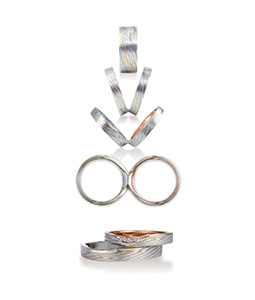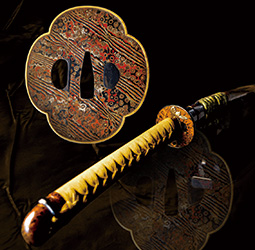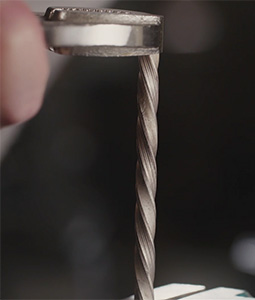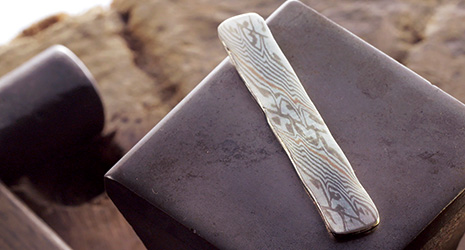
“Tsunagaru-Katachi” wedding rings are cut and formed from a single bar of mokume-gane 
A sword and a tsuba hand guard made using the mokume-gane technique 
A bar combining different-colored metals is twisted before hammering to bring out the wood grain pattern
April 2021
From Swords to Wedding Rings

A traditional Japanese metalworking technique used in the production of hand guards for swords is today being applied to the crafting of engagement, wedding and other rings.

Natural patterns like the grain of wood adorn the surface of a delicately crafted ring. The ring was produced using the mokume-gane (literally, wood grain metal) technique developed 400 years ago to decorate the tsuba, or hand guards, of swords. Mokume-gane is a metalworking technique that originated in Japan in which metal with a wood grain pattern is created by repeatedly carving and forging multiple thermally bonded layers of different-colored metals.
Takahashi Masaki, representative director of Mokumeganeya Co., Ltd., succeeded in improving this technique to enable its application in the crafting of rings. “I founded Mokumeganeya in 1997 because I was attracted to the mokume-gane technique while studying in the Metalwork Department of Tokyo University of the Arts. After the edict prohibiting former samurai from wearing swords was issued (1876), it seems the mokume-gane technique waned in popularity for some time. Even so, metalworkers handed down this special technique to the following generations. They sought ways to utilize the technique in contemporary life, instead of permitting it to fall into obscurity again,” says Takahashi.

In the traditional mokume-gane method, metalworkers typically used gold, silver, copper and other metals, and created an oxidized film on the surface of the metals by boiling them with chemical fluids during the final coloring process. However, it isn’t possible to adapt this method to the rings that people wear in their daily lives because these thin films would soon be rubbed away. The company, therefore, crafts rings that feature intricate color patterns by combining different-colored metals such as gold, silver and platinum without the chemical coloring process.
Metals are layered, compressed and thermally bonded. The metal bar produced is then repeatedly hammered, twisted, carved and, finally, polished. These processes are done entirely by hand at Mokumeganeya, ensuring that no two patterns are exactly alike.

The company’s innovative “Tsunagaru-Katachi” (linked shapes) wedding rings are a pair of rings with a continuous mokume-gane pattern on their surface, being cut and formed from a single bar of mokume-gane. The rings received a Good Design Award in 2015 (see the August 2017 issue of Highlighting Japan) and the Ministry of Economy, Trade and Industry’s Monodzukuri Nippon Grand Award in 2019. They also garnered high praise in three major design award competitions overseas: the Red Dot Design Award (Germany), the iF Design Award (Germany) and the IDEA Design Award (United States).
Mokumeganeya also has a range of engagement and wedding rings embedded with diamonds cut in the shape of cherry blossom petals. These rings with their distinctively Japanese motif have been crafted in the hope of popularizing mokume-gane as a Japanese craft around the world.

“Lacquerware and lacquer art are iconic Japanese items, even sometimes called “japan,” says Takahashi. “I strongly hope that people around the world will come to understand the charm of mokume-gane and eventually see it as a technique that symbolizes Japan, just like lacquer-based works.”

